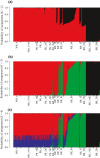Asymmetric introgression between fishes in the Red River basin of Texas is associated with variation in water quality
- PMID: 30847094
- PMCID: PMC6392354
- DOI: 10.1002/ece3.4901
Asymmetric introgression between fishes in the Red River basin of Texas is associated with variation in water quality
Abstract
When ecologically divergent taxa encounter one another, hybrid zones can form when reproductive isolation is incomplete. The location of such hybrid zones can be influenced by environmental variables, and an ecological context can provide unique insights into the mechanisms by which species diverge and are maintained. Two ecologically differentiated species of small benthic fishes, the endemic and imperiled prairie chub, Macrhybopsis australis, and the shoal chub, Macrhybopsis hyostoma, are locally sympatric within the upper Red River Basin of Texas. We integrated population genomic data and environmental data to investigate species divergence and the maintenance of species boundaries in these two species. We found evidence of advanced-generation asymmetric hybridization and introgression, with shoal chub alleles introgressing more frequently into prairie chubs than the reciprocal. Using a Bayesian Genomic Cline framework, patterns of genomic introgression were revealed to be quite heterogeneous, yet shoal chub alleles were found to have likely selectively introgressed across species boundaries significantly more often than prairie chub alleles, potentially explaining some of the observed asymmetry in hybridization. These patterns were remarkably consistent across two sampled geographic regions of hybridization. Several environmental variables were found to significantly predict individual admixture, suggesting ecological isolation might maintain species boundaries.
Keywords: fish; genetic structure; hybridization; introgression; water quality variation.
Figures





References
-
- Allendorf, F. W. , Leary, R. F. , Spruell, P. , & Wenburg, J. K. (2001). The problems with hybrids: Setting conservation guidelines. Trends in Ecology and Evolution, 16, 613–622. 10.1016/S0169-5347(01)02290-X - DOI
-
- Barlow, G. W. (1958). High salinity mortality of desert pupfish, Cyprinodon macularius . Copeia, 1958, 231–232. 10.2307/1440605 - DOI
Associated data
LinkOut - more resources
Full Text Sources
Other Literature Sources

